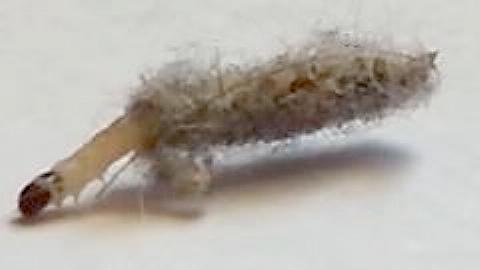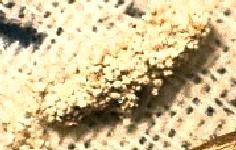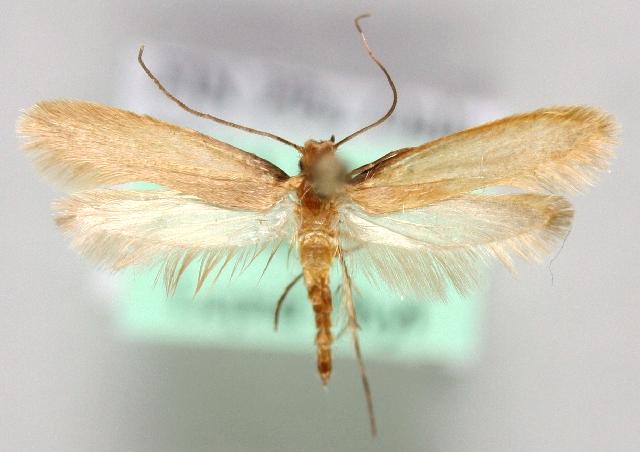
| Webbing Clothes Moth (one synonym : Tinea destructor Stephens, 1825) TINEINAE, TINEIDAE, TINEOIDEA | (donherbisonevans@yahoo.com) and Stella Crossley |

(Photo: courtesy of
Serckep)

| Webbing Clothes Moth (one synonym : Tinea destructor Stephens, 1825) TINEINAE, TINEIDAE, TINEOIDEA | (donherbisonevans@yahoo.com) and Stella Crossley |

(Photo: courtesy of
Serckep)
This Caterpillar was unfortunately introduced into Australia by accident. It is a cosmopolitan pest, particularly known for damaging textiles, both overseas, and in Australia. It is the most common of the four common species of clothes moths. The caterpillar constructs and lives in a silk-lined tubular case covered in the material on which it is feeding, and to which frass and other debris are attached, although the caterpillar can also be found without a case.
The caterpillar is buff coloured, with a dark brown head and collar. The caterpillar commonly feeds in dark, protected areas.

If the environment of the caterpillar becomes too dry or cold, it can enter a dormant period until its conditions improve. Normally it grows to a length of about 1 cm. It pupates using its camouflaged case as a cocoon.

The adult moth is a plain golden brown, with a wingspan of about 1.5 cms. It looks slim because it folds it wings back along its body. Adult moths of the webbing clothes moth are good fliers, but tend to fly in darkened areas. The males normally are the fliers, whereas females generally walk or run. The pheromones of this species have been identified.

Female moths lay about 50 eggs in darkened areas or at night. After the eggs are laid the female dies. The newly born caterpillars can enter any opening greater than 0.01 millimeter, which enables them to enter many storage containers which we might think were secure. The total lifespan (egg, caterpillar, pupa, and adult) varies from 5 to 9 months, although it may exceed 2 years if the larva is triggered to go into a dormant period.
Overseas, it occurs widely, including
In Australia, so far the species has been reported in
Various methods may be employed to control this pest.
Further reading :
Ian F.B. Common,
Moths of Australia,
Melbourne University Press, 1990, p. 184.
Arvid David Hummel,
Essais Entomologiques,
St. Pétersbourg De l'Imprimerie de la Chancellerie privée du Ministère de l'Intérieur,
Volume 1, Part 3 (1823), p. 13.
Peter B. McQuillan, Jan A. Forrest, David Keane, & Roger Grund,
Caterpillars, moths, and their plants of Southern Australia,
Butterfly Conservation South Australia Inc., Adelaide (2019), p. 42.
Gaden S. Robinson & Ebbe S. Nielsen,
Tineid Genera of Australia,
Monographs on Australian Lepidoptera Volume 2,
CSIRO Publishing, Melbourne 1993.
Paul Zborowski and Ted Edwards,
A Guide to Australian Moths,
CSIRO Publishing, 2007, p. 53.
 caterpillar |  butterflies |  Lepidoptera |  moths |  caterpillar |
(updated 25 October 2010, 14 August 2019, 20 October 2020)